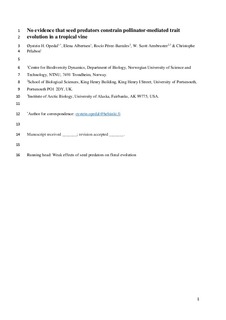| dc.contributor.author | Opedal, Øystein Hjorthol | |
| dc.contributor.author | Albertsen, Elena | |
| dc.contributor.author | Perez-Barrales, Rocio | |
| dc.contributor.author | Armbruster, W.Scott | |
| dc.contributor.author | Pelabon, Christophe | |
| dc.date.accessioned | 2019-04-16T11:36:15Z | |
| dc.date.available | 2019-04-16T11:36:15Z | |
| dc.date.created | 2019-03-18T19:27:22Z | |
| dc.date.issued | 2019 | |
| dc.identifier.citation | American Journal of Botany. 2019, 106 (1), 145-153. | nb_NO |
| dc.identifier.issn | 0002-9122 | |
| dc.identifier.uri | http://hdl.handle.net/11250/2594812 | |
| dc.description.abstract | Turnover in biotic communities across heterogeneous landscapes is expected to lead to variation in interactions among plants, their mutualists, and their antagonists. Across a fragmented landscape in northern Costa Rica, populations of the euphorb vine Dalechampia scandens vary widely in mating systems and associated blossom traits. Previous work suggested that populations are well adapted to the local reliability of pollination by apid and megachilid bees. We tested whether variation in the intensity of predispersal seed predation by seed weevils in the genus Nanobaris also contributes to the observed variation in blossom traits.
We studied spatiotemporal variation in the relationships between floral advertisement and the probability of seed predation within three focal populations. Then we assessed among‐population covariation of predation rate, pollination reliability, mating system, and blossom traits across 20 populations.
The probability of seed predation was largely unrelated to variation in floral advertisement both within focal populations and among the larger sample of populations. The rate of seed predation was only weakly associated with the rate of cross‐pollination (allogamy) in each population but tended to be proportionally greater in populations experiencing less reliable pollination.
These results suggest that geographic variation in the intensity of antagonistic interactions have had only minor modifying effects on the evolutionary trajectories of floral advertisement in plant populations in this system. Thus, pollinator‐driven floral trait evolution in D. scandens in the study area appears not to be influenced by conflicting seed‐predator‐mediated selection. | nb_NO |
| dc.language.iso | eng | nb_NO |
| dc.publisher | Botanical Society of America | nb_NO |
| dc.title | No evidence that seed predators constrain pollinator-mediated trait evolution in a tropical vine | nb_NO |
| dc.type | Journal article | nb_NO |
| dc.type | Peer reviewed | nb_NO |
| dc.description.version | acceptedVersion | nb_NO |
| dc.source.pagenumber | 145-153 | nb_NO |
| dc.source.volume | 106 | nb_NO |
| dc.source.journal | American Journal of Botany | nb_NO |
| dc.source.issue | 1 | nb_NO |
| dc.identifier.doi | 10.1002/ajb2.1209 | |
| dc.identifier.cristin | 1685713 | |
| dc.description.localcode | © 2019. This is the authors’ accepted and refereed manuscript to the article. Locked until 9.01.2019 due to copyright restrictions. | nb_NO |
| cristin.unitcode | 194,66,10,0 | |
| cristin.unitname | Institutt for biologi | |
| cristin.ispublished | true | |
| cristin.fulltext | preprint | |
| cristin.qualitycode | 1 | |
